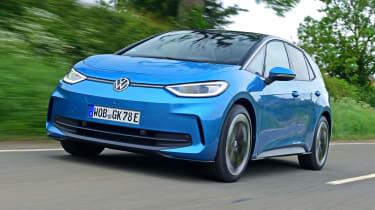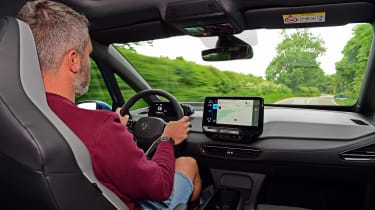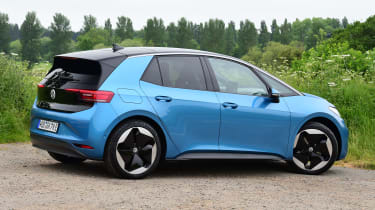Volkswagen has refreshed the ID.3 to keep up with the ever-increasing competition, but some original bugbears remain
3.5 out of 5
Verdict
The updated ID.3 shows progress in plenty of places, but that slow, glitchy infotainment system remains a bone of contention. Our advice would be to hold out for another 12 months and see whether further improvements in this area materialise – upgrades to this key touchpoint could easily earn the electric Volkswagen an extra half-star. Especially as elsewhere, the ID.3 finally feels worthy of its billing as the people’s EV.
For decades, the Volkswagen brand blurred the boundaries of premium and mainstream, offering the kind of kit and quality you’d expect from luxury manufacturers but at a much more affordable price.
But in recent years, VW started to lose its foothold. The evergreen Golf has been surpassed by talented competition, while its first dedicated electric car – the ID.3 – suffered immediate criticism for its glitchy infotainment tech and sub-par interior trim.
Best electric cars to buy 2023
- The best long-term car tests 2022
- MG5 vs Volkswagen ID.3: 2022 twin test review
- Volkswagen ID.3 vs Nissan Leaf
- Volkswagen ID.3 review
- Volkswagen ID.3 Pro S Tour: long-term test review
- New Volkswagen ID. X concept ride review
- New Volkswagen ID.3 Tour Pro S 2021 review
The result – and 12 months earlier than planned – is a hefty mid-life facelift that looks to address some of the MG4 and Kia Niro EV rival’s biggest flaws. Particular attention has been paid to the car’s cabin, whereby stitched fabric has been added to the doors and dashboard, while subtle changes to the exterior design and extra colours give it greater kerb appeal.
More reviews
Car group tests
In-depth reviews
Long-term tests
Road tests
But we’ll start inside, where the perceived quality takes a welcome hike in the right direction. By addressing those core areas of concern, the ID.3 now feels like a product befitting of its near-£40,000 price tag. At least until you’re forced to interact with the standard-fit 10-inch touchscreen.
There’s no avoiding it either – everything from the radio and media, to the navigation and driver assistance systems are buried within the unaltered, hesitant and often tricky-to-operate central display. From next year – which, incidentally, is when the ID.3 was initially due for its lifecycle update – UK buyers will get a larger, upgraded 12-inch screen. For now the fiddly and unlit touch-sensitive climate sliders also remain.
The ID.3 is now only available in Pro and Pro S specs, with the latter getting the larger 77kWh battery that VW claims is now good for 347 miles on a charge. Going for the S also brings faster 170kW charging (Pro cars are pegged at 120kW) which slashes the 5-80 per cent top-up time to less than half an hour despite the bigger battery.
We were impressed with our car’s efficiency, actually. Showing well over 200 miles on collection (at 92 per cent state of charge) we averaged over 3.3mi/kWh during our test – even when attempting to assess the car’s dynamic ability. We reckon closer to 4mi/kWh would be possible in normal driving.
Speaking of which, there really is very little to take issue with when it comes to what the ID.3 feels like from behind the wheel. The brake pedal can appear a little wooden at times and the ride is on the firm side, but you’d never call the car uncomfortable – even with the optional adaptive dampers in their stiffer setting.
Indeed, the ID.3 continues to appear pleasingly adept in myriad situations. It’s as fast as you’d need a car like this to be, and the rear-mounted motor and low centre of gravity ensure grip is good and body control tight. The electric VW feels keen to turn in, and while the steering isn’t brimming with feel, it is at least consistently weighted.
The ID.3 is refined, too, even on 20-inch wheels. These are a £1,580 option we’d happily forgo, but we’re pleased to report Volkswagen no longer fits plastic wheel trims to base cars; how a mainstream manufacturer previously considered it appropriate to fit hubcaps to its BMW-baiting family car is anyone’s guess.
Otherwise, the ID package continues to offer a relatively roomy cabin, and the same 385-litre (1,267 litres with the seats folded down) boot. Big-battery cars still only get four seats, however, so if you want to carry five – even occasionally – then you’ll need to sacrifice some of that outright range and opt for the 58kWh car.
As mentioned, the Pro and Pro S trims largely correspond to your desired battery choice, but there are subtle differences to the spec sheet. The more expensive (+£5,755) model upgrades from 18 to 19-inch wheels, and also brings VW’s excellent ergoActive seats with electrically-operated lumbar support.
New colours – like our Costa Azule Metallic – start from £710, while an energy efficient heat pump can be added for £970. All cars come with LED lights, wireless phone charging and Volkswagen’s ‘Discover Pro’ navigation system, plus heated seats and keyless go.
| Price: | £37,115 |
| Powertrain: | 58kWh battery, 1x e-motor |
| Power/torque: | 201bhp/310Nm |
| Transmission: | Single-speed auto, rear-wheel drive |
| 0-62mph: | 7.4 seconds |
| Top speed: | 99mph |
| Range/charging: | 265 miles/120kW, 5-80% in 35 mins |
| On sale: | Now |
Now read more about the upcoming Volkswagen ID.7…
Source: Read Full Article



 Best electric cars to buy 2023
Best electric cars to buy 2023
